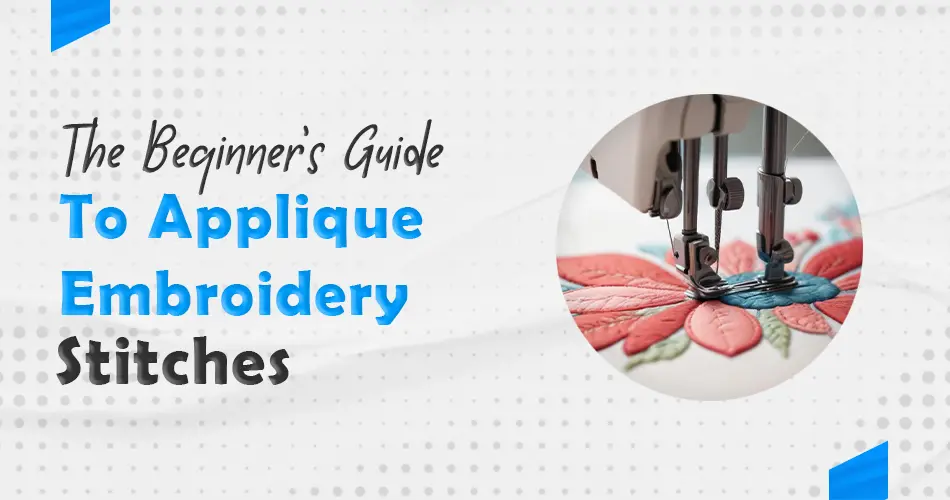Embroidery has been an important part of human culture for centuries, and appliqué embroidery has added a whole new dimension to this age-old craft. In this post, we will explore the world of applique embroidery stitches , its origins, different types, essential tools, the process, and some tips to perfect your craft.
Understand applique embroidery stitches
When you get into the beautiful appliqué stitch, you will quickly realize that it is much more than a simple stitch. It is the blood that connects the small fabrics with the big ones to show a beautiful design. Think of appliqué embroidery as a fun fabric collage, where different layers come together to tell a story, all held together by humble stitches.
Stitching creates a unique depth and texture, adding layers of mystery and a bit of color to the design. The latest masterpiece is a testament to the power of details – a beautiful design that adds elegance and grace to any textile. Whether it’s a floral pattern on a cushion cover or an abstract pattern on a wall, functional embroidery turns the ordinary into the extraordinary. Join us as we continue to explore this fascinating world of sewing where every stitch is a brush on the duster.
The origin of applique embroidery
Applique sewing, like many art forms, has a rich tapestry of global origins. The word “applique” comes from the French “applique”, which means “to apply”. However, the origin of the technique extends far beyond France and finds a basis in cultures throughout Africa, America, and Asia. The first use of the application was born from practicality rather than creativity, it was used to organize clothes and expand their use. However, with the movement of the hands of time, the evolution of the application has also fallen.
The inclusion of intricate appliqué stitches elevated the craft to new heights, giving artists a creative means to inject an intricate level of detail into their designs. So, as we delve further into the world of appliqué embroidery, let’s pay tribute to its humble beginnings and the world journey that brought it to life.
Types of embroidery stitches
Dive deep into the heart of appliqué embroidery by exploring a variety of stitch collections. From the simplicity of a straight weave to the depth of a satin weave, each type has a unique beauty and purpose.
A straight stitch or running stitch is the backbone of the appliqué, which attaches the piece of fabric to the base. It offers simplicity but can be used creatively to add texture and design to your app.
Quilt stitch, a decorative stitch typically used to finish the edges of a quilt, is another applique favorite. The flared edge is not only practical but also adds a sense of creativity and fun to your design. Finally, we have the Buttonhole Stitch, similar to the blanket stitch but offering a denser finish. It’s resilient, sturdy and ensures your applique stands the test of time.
And these are just a few examples! There are many more stitches to explore, each offering different levels of intricacy, durability and aesthetic appeal. As you navigate through the creative labyrinth of applique embroidery, don’t be afraid to experiment and find the stitches that resonate with your style and vision.
Essential Tools for Applique Embroidery
To embark on your journey through the captivating realm of applique embroidery, you’ll need to arm yourself with the right tools. Imagine an artist preparing for a masterpiece – each brush, each color, each canvas playing a pivotal role in bringing their vision to life. Similarly, each tool in applique embroidery stitches has a unique purpose that aids in creating your textile wonder.
Your canvas here is the base fabric, a plane waiting to be adorned by your creativity. It’s the stage where your embroidery story unfolds. Next, the actors of your tale – the fabric pieces for your applique. These are the fragments that, when stitched together, create a design that tells a tale of your creativity.
The embroidery needles and thread play a dual role
They are both the brushes and the paint. The needles manoeuvre the thread, weaving it through the fabric to bind your design together. The thread, available in a variety of colors, breathes life into your design, adding depth, texture, and character.
An embroidery hoop is your easel. It provides stability, ensuring your fabric remains taut as you stitch your design onto it. And finally, the sharp scissors, you’re carving tool. They cut and shape the fabric pieces, helping you achieve the precision your design requires.
Optional aids like transfer paper or stencils can also play a supportive role in sketching your design before you dive into the stitching process. With these tools in hand, you’re all set to step into the enchanting world of applique embroidery!
The Process of Applique Embroidery
Embarking on your applique embroidery adventure begins with choosing a design. This blueprint will guide your stitches and determine the fabric pieces needed. The next step involves tracing your design onto your base fabric, your blank canvas. You can use transfer paper or even freehand sketching, depending on your comfort level. Now, it’s time to cut out the fabric pieces for your applique. These are your characters, and they are ready to be staged!
Using your chosen applique embroidery stitch, start affixing the fabric pieces onto your base fabric. Remember, the stitch you choose can add texture, depth, and individuality to your piece. This stage is like painting on a canvas, but instead of paint, you’re using thread and needles.
Tips and Tricks for Successful Applique Embroidery
Embarking on the journey of applique embroidery can be a delightful adventure. Here are some savvy tips to guide you along the way:
1. Take it slow: Rushing your stitches could lead to errors that are time-consuming to rectify. Remember, the beauty of applique lies in the details, so take your time.
2. Experiment with stitches: Don’t limit yourself to just one type of stitch. Experiment with a variety to create unique textures and finishes.
3. Keep your fabric taut: An embroidery hoop can assist in keeping your fabric smooth and flat, making it easier to manage your stitches.
4. Care for your tools: Keep your scissors sharp and your needles in good condition. These are your craft allies; treat them with respect.
Conclusion
So, you’re now acquainted with the alluring world of applique embroidery stitches – the history, the types, the tools, and the process. Applique embroidery is indeed a fascinating and creative craft, with endless possibilities. Remember, it’s not just about the finished piece but also about the journey to create it. Embrace each stitch, cherish each design choice, and relish the process. Whether you’re a seasoned embroiderer or just starting, there’s always room for growth, for exploration, and for new creations.
With patience, practice, and the helpful tips we’ve shared, you’re well-equipped to start your applique embroidery adventure. Let your imagination soar and let your stitches weave a tale of creativity. Your journey into the enchanting world of applique embroidery has just begun – and it’s set to be a thrilling and fulfilling voyage! So, pick up your needle, thread, and fabric, and embark on your unique embroidery journey. Happy stitching!




